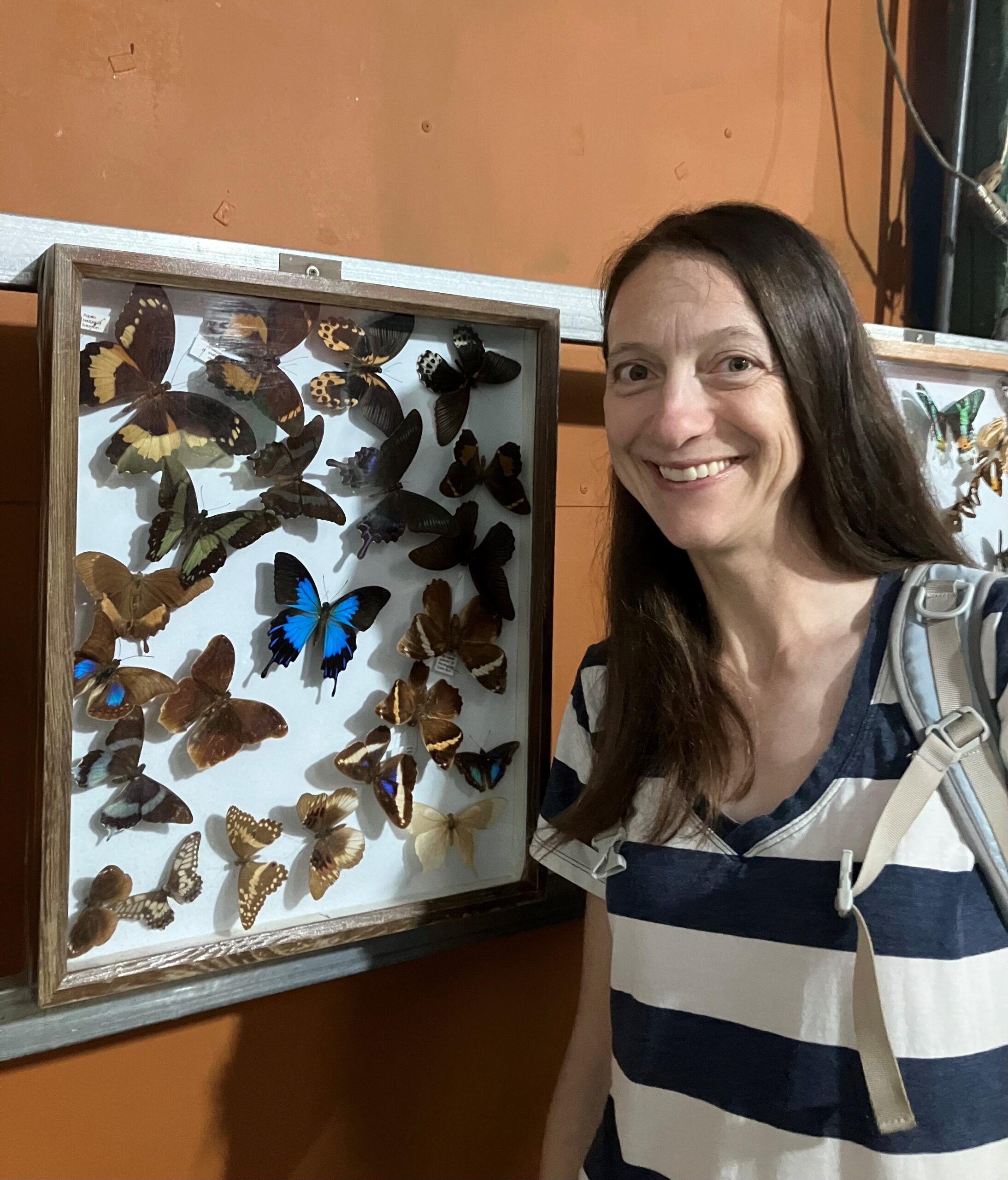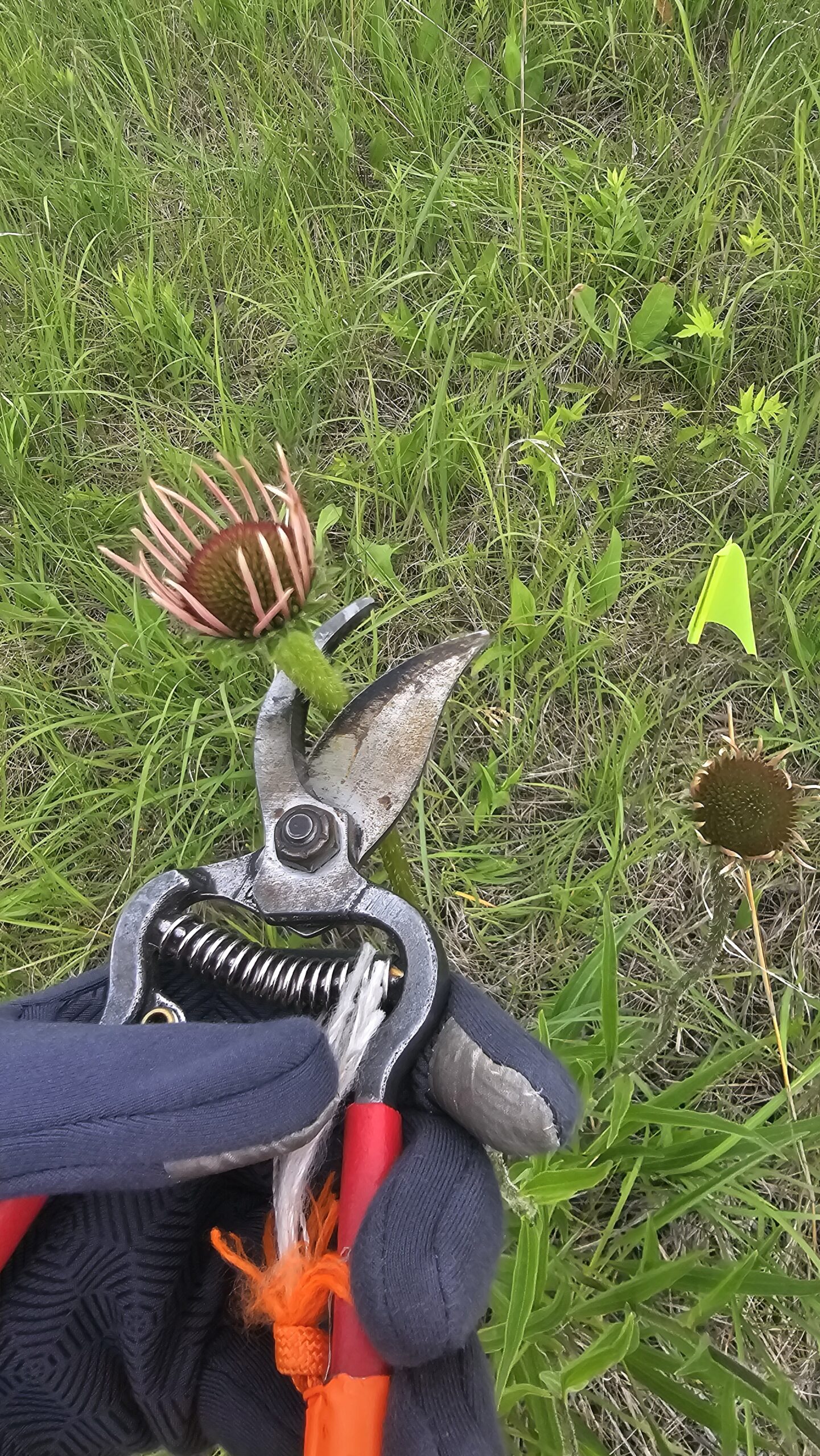Today was the first day of total demography! Team Echinacea started as a whole group at Tower, a remnant prairie site, where Jared gave an overview of total demography. Team Echinacea learned important skills such as communication and collaboration. After total demography was finished at Tower, one group headed to Martinson Approach and another went to East of Town Hall. Echinacea angustifolia pollen has seemed to wind down in the past few days. Today, Grace and Rebecca collected the remaining pollen from the last flowering plants. In the afternoon, everyone had personal project time!
|
||||
|
Today Team Echinacea continued to wrap up the pollen and nectar collection. Only a few focal plants are still in flower. Another group worked on flagging and recording demographic information for every flowering Echinacea plant in every remnant site. Some of these plants have tags dating back decades! In the experimental plots, Stuart trained team members to find and measure all Echinacea. This data will help us understand performance of E. angustifolia x pallida hybrids. Round 5 of emergence trapping started recently. The team members are now pros at deploying and retrieving the traps.  It’s heating up in western Minnesota! Temperatures and humidity were high today. In the morning, much of Team Echinacea performed the pollinator observations we learned about yesterday with Dr. Ison. These involved recording the pollinator with a camcorder, describing its activities, and attempting to ID to morphospecies level.  In the afternoon, emergence trapping crews had a great session of deployments and retrievals, while others worked on phenology in the common garden plots, and others gathered nectar. It’s exciting to see new species starting to bloom: two major species of prairie clover are just getting started, as is the wild bergamont and wild licorice.  Once everyone was back from the field, we enjoyed some ice cold watermelon and headed home. Another great day in the field! This week was a busy Monday for team Echinacea. Jennifer from College of Wooster joins us this week along with her research assistants Max and Indigo! This morning started off with round 2 of sweet clover pulling, and was promptly followed by a crash course in pollinator observations. We tried our hand in collecting species in small tubes for ID and then release. A big part of this was learning how to differentiate between flys and bees as some flies can look realllyyy close to a bee. But don’t be fooled! To round out the morning we went out in groups to collect pollen for our pollen and nectar study specifically looking at echinacea angustifolia. After lunch, half of us went and deployed another round of emergence traps while the other half went out and did nectar collection for the pollen and nectar study. This morning the whole team got together to pull as much sweet clover as we could from p01. After the drippy morning faded, we split up to collect pollen from Echinacea angustifolia at sites throughout the area. This is part of an MN ENRTF funded project to help determine the impacts of prescribed burns on pollen and nectar quantity and quality in echinacea. After lunch, some people went to retrieve and deploy emergence traps and the rest of us went to collect nectar from echinacea plants. To collect the nectar, we are using tiny glass microcap tubes carefully inserted into the florets. Overall, we had a productive day, and enjoyed the nice weather after a wet 4th!  The beginning of flowering for Echinacea angustifolia means it’s time for Team Echinacea to get collect Echinacea pollen and nectar! This project is part of our MN ENRTF funded research to understand fire’s impacts on ground nesting bee habitat and food resources. It’s our second year of sampling and we have made some modifications and improvements to our protocol. This year we are collecting from a total of 62 plants across 12 sites (some burned in 2023, some in 2024, and a few not burned in either year). Where possible, we are collecting from plants that we also collected from last year, which will make for some interesting comparisons. Many plants did not re-flower in 2024, so Wyatt and I bolstered our sample by randomly selecting other focal plants. On Monday, Wyatt and I visited our first flowering focal plants with Grace and Rebecca from NDSU and tested out methods. We learned how to sample immature florets, a new method we are using to assess pollen quantity this year. We also brushed up on nectar and pollen collection. By Tuesday we were able to train the whole team in on the protocol and start collecting! So far our data sheets have worked pretty well, and we are figuring out ways to improve efficiency in the field. Stay tuned as more of our focal plants begin to flower! Today we welcomed goats to Hjelm. They are already hard at work eating their way through the foliage. Keep up the good work, goats! Most of the humans worked on finishing searching for Stipa in p01 and started planting a new production garden to generate seed to add to the experimental plots. Ian and Liam valiantly continued staking points for the pollinator emergence study. Wyatt and Abby are getting ready to begin a study investigating the effects of fire on pollen and nectar production in Echinacea angustifolia. This project has many excellent collaborators and is part of the MN ENTRF funded research on prescribed fire and ground nesting bees.   I am a high school science teacher from La Salle High School in Yakima, Washington. Before I was a teacher, I was an ecologist studying plant communities in savanna landscapes. At La Salle, our campus contains nine acres of restored riparian habitat that we manage in partnership with the Yakama Tribal Fisheries Project. My goal this summer is to participate in and learn from Echinacea Project’s ongoing activities and to develop a long-term research project to bring home for science students at La Salle.  Today the team conducted the second day of Stipa search. This time we came back to know points with Stipa plants using our visor and confirmed if a plant was present. The team learned how to differentiate basal Stipa plants from other grasses in the plot and confirmed the presence of many Stipa grasses that weren’t logged during our first day of Stipa search. In the afternoon the team worked on staking more BB points and collecting/setting up more emergence traps. Today the team went out to Hegg Lake to flag flowering echinacea along with decapitating some pallida. We were joined by collaborators from NDSU who collected pallida samples for pollen and nectar studies. It was the first day of taking demographics of the echinacea this season. Taking the demographics went well and we estimated finding anywhere between 80 to 300 flowering echinacea pallida. Later in the afternoon the team split up to work on independent projects. Including, shooting bb points with the gps, working on proposals, and flagging more echinacea.  |
||||
|
© 2025 The Echinacea Project - All Rights Reserved - Log in Powered by WordPress & Atahualpa |
||||





